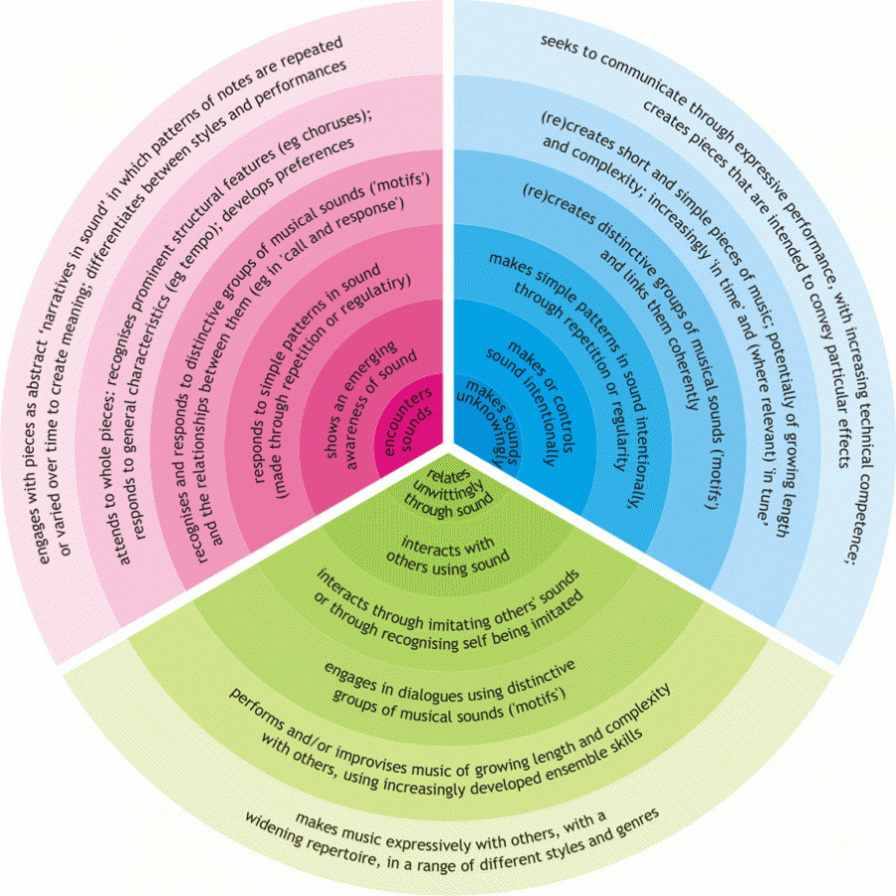Using Sounds of Intent at Belvue School

Another Exchanging Notes term has been and gone at Belvue School in Ealing and we are about to begin the summer term, which will see us finishing off year 1 of this 4 year Youth Music funded project.
Since my last blog I have been continuing to use the Sounds of Intent (SOI) framework of musical development to make assessments and record the progress of the young musicians. Using the SOI framework means I can keep track of the young musicians progress and my assessments, upload my own session notes and thoughts and explore ideas to support the young musicians in their musical development. I have been asked on different occasions, how I use SOI in this context. So in this blog, I hope to give you a good idea as to why I use SOI as the basis for recording progress, making assessments and how it is helping to steer the lessons.
What is Sounds of Intent? ‘The ‘Sounds of Intent’ research project was set up in 2002 jointly by the Institute of Education, Roehampton University, and the Royal National Institute of the Blind.
The aim of Sounds of Intent is to investigate and promote the musical development of children and young people with learning difficulties – although the system can also be used effectively with adults.
The research team has developed a framework of musical development that covers the whole range of ability from profound and multiple learning difficulties (PMLD) to those with autism, with or without exceptional musical abilities (so-called savants). The model is underpinned by zygonic theory – which seeks to explain how music makes sense to us all. The theory has been used to predict the order in which the musical abilities it implies are likely to evolve in children, irrespective of their learning difficulties’
It is free to use the SOI framework and resources from the website:http://soundsofintent.org/
How do you use the framework and website? The heart of the Sounds of Intent website is the framework The framework is available as text or as an interactive graphic There are 3 domains, Reactive, Proactive, and Interactive There are 6 levels which begin from the inside circle (level 1), to the outside circle (level 6) There are 4 different elements (A, B, C, D) within each level descriptor
A helpful feature embedded into the SOI website is the navigation tool which is a menu box that follows you wherever you go on the website, meaning you can quickly use the navigation controls to exit the framework, or jump to a new domain or level.
There are also interpretations and strategies on how to develop the activities and a selection of videos giving examples of some musical activities that relates to that domain and level.
You can input session data, which records and translates the information you provide and then creates a graph where you can clearly see the pupil’s developments and progressions.
The content and design of this website has everything required to make pupil assessments, record data and create tables and graphs to reflect the record of interactions.
There is an excellent video on the home page of the website called ‘Sounds of Intent Young Champions’ where a group of young people have created a very clear guide on how to use SOI. It is worth a watch.
Why am I using it in lessons? There have been many years of empirical research into the creation and development of SOI It can support pupils in highlighting their musical skills and creativity It makes very clear comparisons with the ‘P-Levels’ for music and their limitations I use it to back up what I am doing in a lesson, enabling me to explain to teachers and parents my observations of what is happening during a particular musical activity It encourages more questioning about what is actually happening It is a quick and reliable way to record and save session data You can generate and print a table and graph based on the data entered
How is it helping? Using the Sounds of Intent framework helps me to get a really good sense of the learner’s musical interactions during each lesson. I can highlight something positive musically about each learner and back it up, with the framework, video footage and my assessment. It is invaluable that I can film each lesson and store it on the schools network, meaning that I, or another staff member can watch it again to input to assessments. For example, an observation may be: “Learner A’ really enjoys doing ‘call and echo’ on Djembe and keyboard.” But what is really happening during this activity? How do you describe what is happening so that it makes sense to you and anyone else? What domain are you looking at and in what way is the pupil being Proactive, Interactive or Reactive? What level do you think the pupil is within that domain? What element do you think it is, within that level? Below is a table showing some data that I entered for ‘Learner A’ after the initial 5 week assessment period.
Another brief example from this project is: “‘Learner B’ loves playing drum kit and jamming together along with the bass guitar.” Using the SOI framework has helped me to pinpoint the young musician’s current level of improvisation skills by entering the observational data and selecting the engagement and consistency levels which best suit the recorded activity.
Below is a table showing some data that I entered for ‘Learner B’ after the initial 5 week assessment period last year.
For summer term and going into the autumn term, my next steps are to:
- Build on repertoire and song banks
- Review use of current resources
- Work towards ensemble work
Gary Day
Ollie, the school cat

